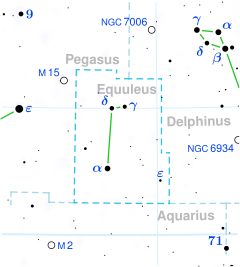Gamma Equulei
Appearance
| Observation data Epoch J2000 Equinox J2000 | |
|---|---|
| Constellation | Equuleus |
| Right ascension | 21h 10m 20.50005s[1] |
| Declination | 10° 07′ 53.6763″[1] |
| Apparent magnitude (V) | 4.69[2] |
| Characteristics | |
| Spectral type | A9 Sr Eu[3] |
| U−B color index | +0.10[2] |
| B−V color index | +0.26[2] |
| R−I color index | +0.10 |
| Variable type | roAp[4] |
| Astrometry | |
| Radial velocity (Rv) | -16.5 ± 0.3 km/s |
| Proper motion (μ) | RA: 48.74[1] mas/yr Dec.: mas/yr |
| Parallax (π) | 27.55 ± 0.62 mas[1] |
| Distance | 118 ± 3 ly (36.3 ± 0.8 pc) |
| Details | |
| Radius | 2.20 ± 0.12 R☉ |
| Luminosity | 12.8 ± 1.4 L☉ |
| Surface gravity (log g) | 4.47[5] cgs |
| Temperature | 8,574[5] K |
| Metallicity [Fe/H] | +0.68[5] dex |
| Other designations | |
| Database references | |
| SIMBAD | data |
Gamma Equulei (γ Equulei, γ Equ) is a double star[6] in the northern constellation of Equuleus. It is located at a distance of around 118 light-years (36 parsecs) from Earth[1] and has an apparent visual magnitude of 4.7.[2]
The primary component is a chemically peculiar star with a stellar classification of A9 Sr Eu[3] and an apparent magnitude of 4.80.[4] Gamma Equulei undergoes periodic pulsations in luminosity, which places it among the category of roAp stars.[7] The surface magnetic field undergoes long term variation with a period of 91.1 ± 3.6 years, ranging from +577 G to –1,101 G.[8] It has a magnitude 9.05 companion at an angular separation of 1.26 arcseconds.[6]
References
- ^ a b c d e van Leeuwen, F. (November 2007), "Validation of the new Hipparcos reduction", Astronomy and Astrophysics, 474 (2): 653–664, arXiv:0708.1752, Bibcode:2007A&A...474..653V, doi:10.1051/0004-6361:20078357.
- ^ a b c d Nicolet, B. (1978), "Photoelectric photometric Catalogue of homogeneous measurements in the UBV System", Astronomy and Astrophysics Supplement Series, 34: 1–49, Bibcode:1978A&AS...34....1N.
- ^ a b Renson, P.; Manfroid, J. (May 2009), "Catalogue of Ap, HgMn and Am stars", Astronomy and Astrophysics, 498 (3): 961–966, Bibcode:2009A&A...498..961R, doi:10.1051/0004-6361/200810788.
- ^ a b c "del Ara -- Star in double system", SIMBAD Astronomical Database, Centre de Données astronomiques de Strasbourg, retrieved 2012-07-27.
- ^ a b c Koleva, M.; Vazdekis, A. (February 2012), "Stellar population models in the UV. I. Characterisation of the New Generation Stellar Library", Astronomy & Astrophysics, 538: A143, arXiv:1111.5449, Bibcode:2012A&A...538A.143K, doi:10.1051/0004-6361/201118065.
- ^ a b Eggleton, P. P.; Tokovinin, A. A. (September 2008), "A catalogue of multiplicity among bright stellar systems", Monthly Notices of the Royal Astronomical Society, 389 (2): 869–879, arXiv:0806.2878, Bibcode:2008MNRAS.389..869E, doi:10.1111/j.1365-2966.2008.13596.x.
{{citation}}: CS1 maint: unflagged free DOI (link) - ^ Perraut, K.; et al. (February 2011), "The fundamental parameters of the roAp star γ Equulei", Astronomy and Astrophysics, 526: A89, arXiv:1011.2028, Bibcode:2011A&A...526A..89P, doi:10.1051/0004-6361/201015801.
- ^ Bychkov, V. D.; Bychkova, L. V.; Madej, J. (January 2006), "Secular variability of the longitudinal magnetic field of the Ap star γ Equ", Monthly Notices of the Royal Astronomical Society, 365 (2): 585–589, arXiv:astro-ph/0510529, Bibcode:2006MNRAS.365..585B, doi:10.1111/j.1365-2966.2005.09738.x.
{{citation}}: CS1 maint: unflagged free DOI (link)

